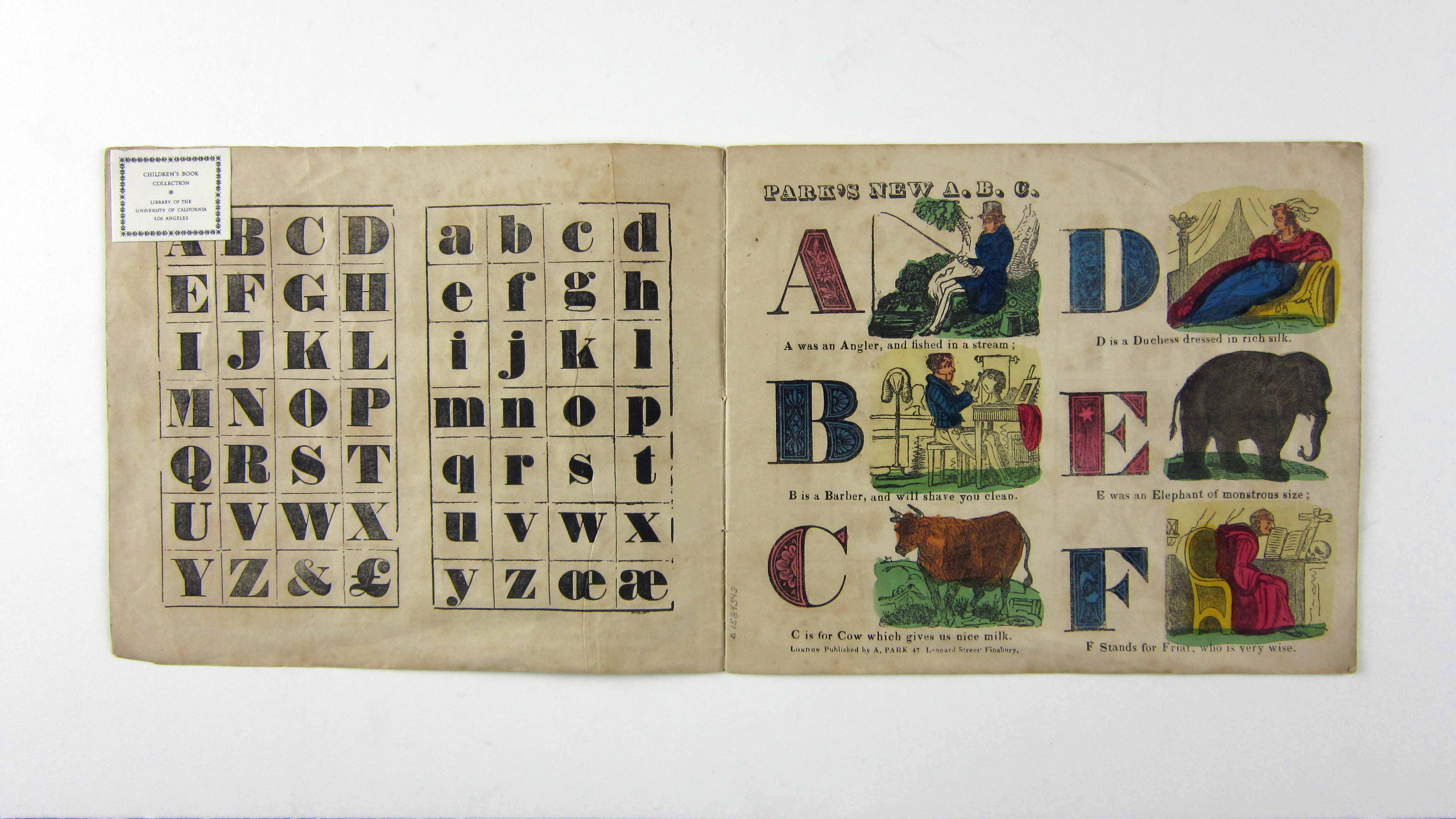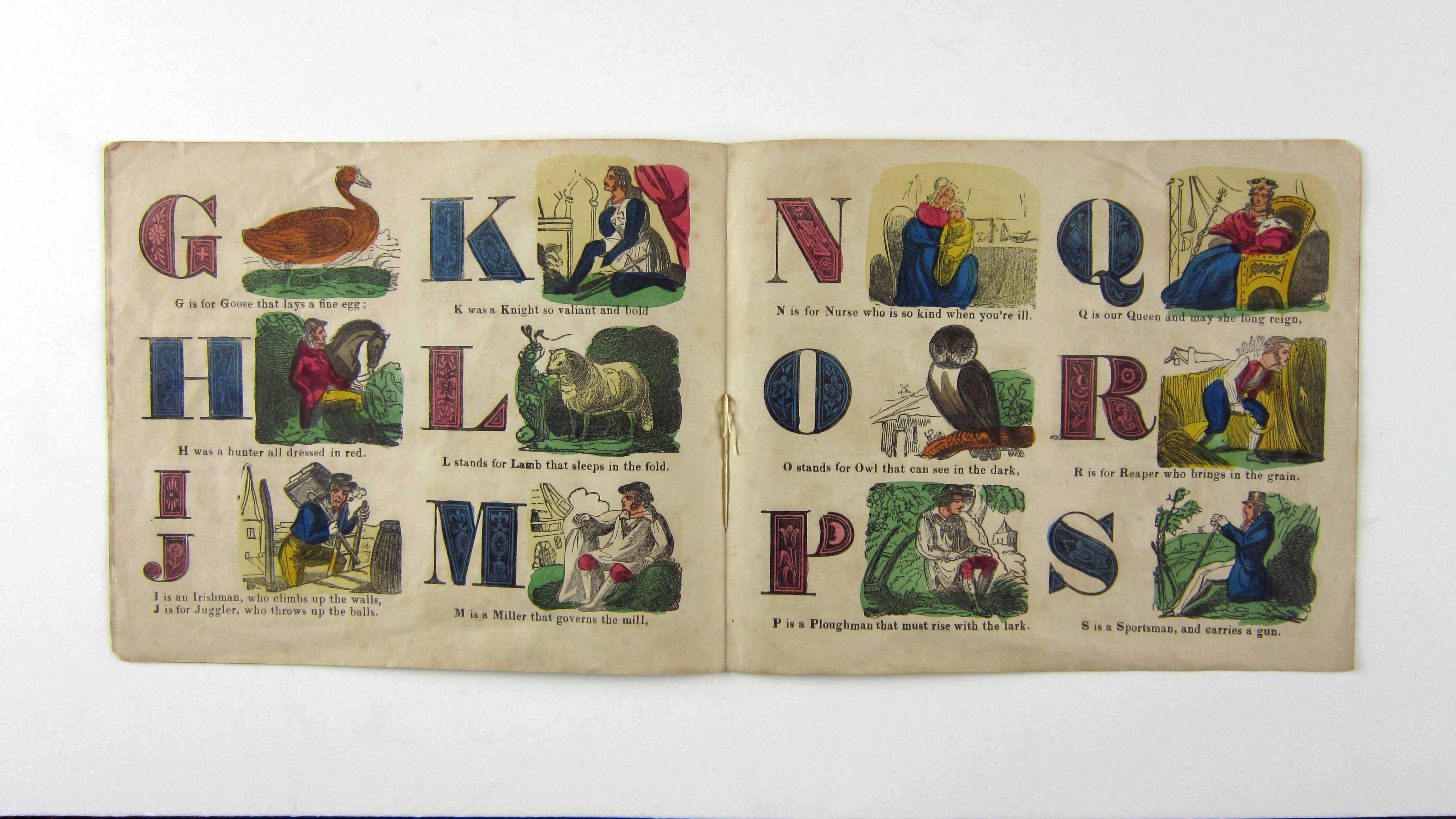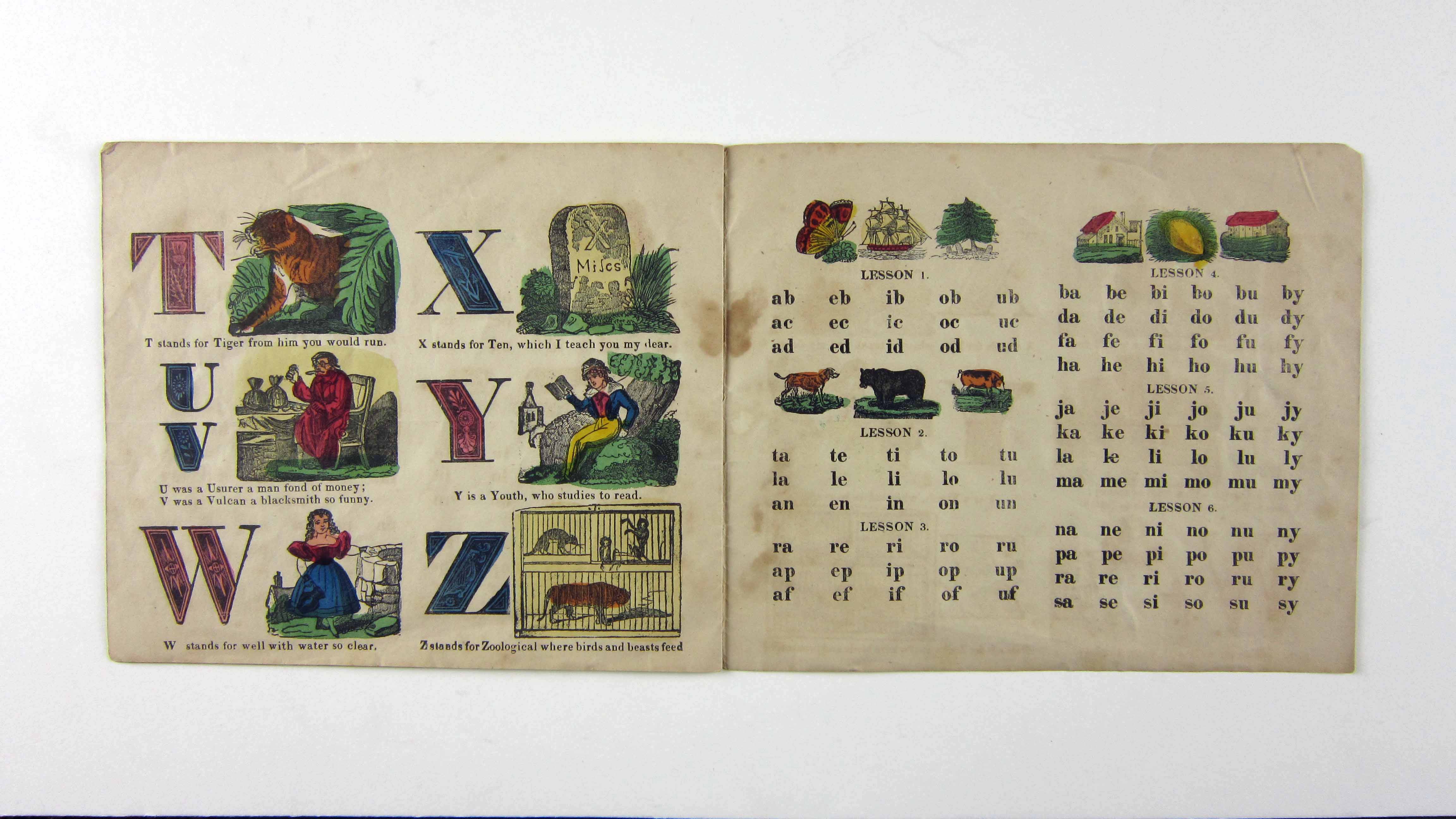

Alphabet books offer a vivid insight into the history of literacy and culture, as well as concepts of childhood. The Children's Book Collection at UCLA contains a rich array of these materials, some well-worn and much-used, some still bright and fresh. Each is a gem of print production and graphical imagery from another time and place. Though the history of alphabet books continues to the present, this exhibit focuses on the works in our collections published between 1700 and 1900, including horn books, primers, works of didacticism and seriousness, whimsy and play.
2. A Jumble ABC
3. A Little Pretty Pocket-Book
4. A New Lottery Book of Birds And Beasts
5. A Pretty Play-Thing for Children of All Denominations
8. ABC of Objects for Home And School
10. ABC with Pictures & Verses
12. Alphabet Et Instruction Pour Les Enfans
16. Dolly's ABC Book
17. Flora's ABC
18. Home ABC
22. Hornbook C. 1700
23. Large Letters for the Little Ones
24. Little ABC Book
25. Little People: An Alphabet
26. Martin's Nursery Battledoor
27. Mother Goose ABC
28. My Darling's ABC
29. Orbis Sensualium Pictus Quadrilinguis
30. People of All Nations: A Useful Toy for Girl Or Boy
31. Picture Alphabet
32. Pretty ABC
33. Railway ABC
34. Rusher's Reading Made Most Easy
38. The Alphabet of Old Friends
40. The Amusing Alphabet for Young Children Beginning To Read
42. The Child's Christian Education
45. The Easter Gift
47. The Favorite Alphabet for the Nursery
49. The Franklin Alphabet And Primer
51. The Golden ABC
55. The Moral And Entertaining Alphabet
57. The Old Testament Alphabet
59. The Picture Alphabet for Little Children
62. The Sunday ABC
63. The Union ABC
64. The Young Child's ABC, Or, First Book
65. Tom Thumb's Alphabet: Picture Baby-Books
67. Warne's Alphabet And Word Book: with Coloured Pictures
68. Wood's Royal Nursery Alphabet
Title Victoria Alphabet






Brief description Victoria Alphabet is a chapbook with wood engravings. It is six leaves, small- 18x22 cm, hand colored, and held together by one staple.
Full description The Victoria Alphabet was published between 1867 and 1871 in London, England, and disseminated throughout the Americas and British colonies. The simple rhymes and pithy representations in the book familiarized children with their letters and social roles and expectations. Once a child memorized the alphabet and text, she could practice her sounds using the lessons at the very end of the book. This book is one of many chapbooks used to teach children to read and write at the end of the nineteenth century.
Literacy Literacy among working class and poor populations during the Victorian era was low, but improving. Employers and rulers were coming to understand the importance of schooling on the general population. Children who learned to read and write at school proved to be more reliable worker than those educated at home or not at all. In addition to being familiar with their letters and basic arithmetic, children educated at school learned to obey the clock, respect their social order, and to cooperate with children from different backgrounds. Success in Victorian England required subjects to understand the importance of hygiene, godliness, country and Queen. School socialized children in the ways of the factory and familiarized them with habits and expectations their social betters expected of them. Many children left school after a few years and worked full time in factories from the time they were 12 or 14 until they were too old to work. Victoria Alphabet exemplifies many types of literacy necessary to a successful subject, cultural literacy, moral literacy, and social literacy. Nearly half of the occupations features in the book focus on workman's roles while the rest deal with nature and class position. Despite a short formal period for education, poor children retained social, cultural, and moral values inculcated at school.
Childhood Children reading the Victoria Alphabet were expected to grow into loyal subjects and pious Christians. English children in the Victorian era were taught to be perfectly obedient to their superiors, to love God and Country, and to aspire to moral perfection. Joseph Zornado's work, Inventing the Child, portrays the life of a Victorian child through the lens of imperialist pedagogy. Wealthy Victorian children are portrayed living a life of luxury and importance, but he shows how they were cruelly held to an impossible standard of emotional and social control. There were exceptions of course, but wealthy Victorian children were kept separate from their parents, exposed to cruel treatment by superiors, and were silenced by educational and religious hierarchal structures. A child reading the Victoria alphabet would have been familiar with the comforting rhyme scheme and may have been asked to recite parts of the book to her mother or governess as a part of her lessons. Images in this book reflect the ideal of a well ordered life and society. The only child in the book is a boy occupied with leisurely reading under a tree. The women, foreigners, and animals seem to exist to please men. Note that Q is for Queen, while K is for Knight. All subjects were expected to serve the crown no matter what their station in life.
Iconography Each image in the Victoria Alphabet supports the well-ordered ideals of Victorian society. The book is composed of rhyming couplets and neat images of people places and things that would have been familiar to a Victorian child. In this book women are elegant, nurturing, and industrious. The duchess wears fine clothes, while the nurse comforts a sick child and the maid happily gathers water from the well. The Queen is the only exception to representations of women, underscoring the belief that the Monarch was held to a different standard of dress and behavior than her subjects. This book is small and simple and was created using wood engravings later colored. This simple chapbook was published in England. Its publishers intended it to be disseminated to children of all ages and classes. Working class children attending privately funded Sunday schools or factory schools would learn their alphabet and the proper order and place of people, animals, and ideas in Victorian society.
Production The Victoria Alphabet is one of many chapbooks produced to teach children their letters and other lessons important to life and culture in the era. This book is produced in six leaves on inexpensive paper with images that are probably used in other publications produced by A. Park in his London shop. A book such as this one was probably given as a prize or gift to a child who completed his lessons or minded the teacher that week. Peddlers selling such as book would have travelled from town to town offering these little books containing poetry, moral tales, history, and love for beginning and advanced working class readers to enjoy.
Publisher A. Park
Publication place Bedford Street, Finsbury
Date 1867
UCLA Call Number CBC * GR486 .V53 1867
Repository UCLA Charles E. Young Research Library, Dept. of Special Collections
Dimensions 18 cm x 22 cm
Technologies of production Color wood engravings
Media and Materials Paper, Ink